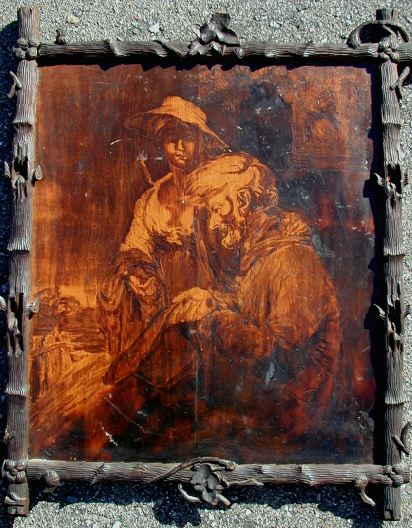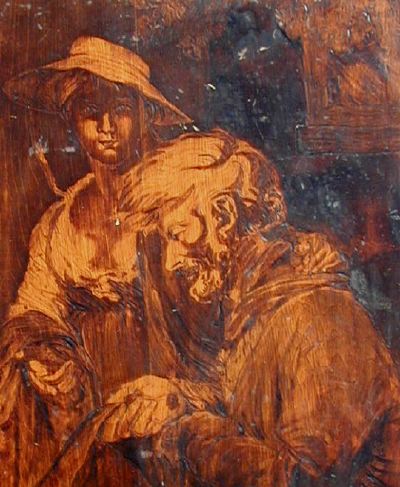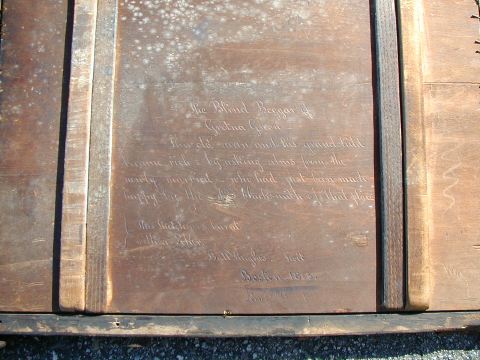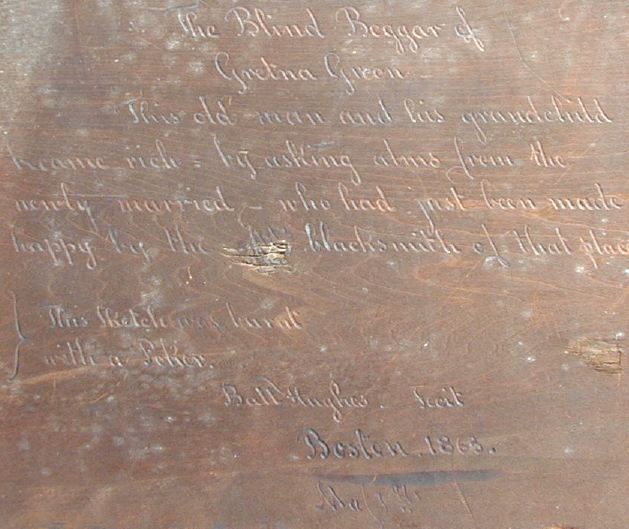E-Museum of Pyrographic ArtAntique Art Hall
|
| - Café Flambé - | - Portraits and Paintings - | - Decorative and Applied Art - |
| - Folk and Traditional Art - | - Antique Art - | - Special Hall - | - Sculpture - |
| - Children's Hall - | - Bookstore and Library - | - Tools and Techniques - |
 |
| The Blind Beggar of Gretna Green, By Ball Hughes, Boston,1863 Poker work on wood plaque, 19.25 in. by 22.25 in. Digital image thanks to Michael Gildengorin |
 |
| The Blind Beggar of Gretna Green,detail By Ball Hughes, Boston,1863 Poker work on wood plaque, 19.25 in. by 22.25 in. Digital image thanks to Michael Gildengorin |
 |
| The Blind Beggar of Gretna Green Pyroengraved inscription on the back of the plaque By Ball Hughes Poker work on wood plaque, 19.25 in. by 22.25 in. Digital image thanks to Michael Gildengorin |
 |
| The Blind Beggar of Gretna Green Detail of the pyroengraved inscription on the back of the panel By Ball Hughes Poker work on wood panel, 19.25 in. by 22.25 in. Pyroengraved inscription on the back reads: The Blind Beggar of Digital image thanks to Michael Gildengorin |
Michael Gildengorin recently acquired the above piece signed Ball Hughes. (Note: the word fecit that follows his name is a Latin word, less commonly used today, that simply means he made it.)
It is believed this is a work by Robert Ball Hughes, the English sculptor who emigrated to America and lived in Dorchester, Massachusetts. He did the Alexander Hamilton statue that was burned in the fire of 1835 (for which models remain in the Metropolitan Museum of New York) and miniaturist who modified the Gobrecht design of Lady Liberty, which appeared on many U.S. minted coins from 1840 on.
This piece is highlighted in "Pyrograffiti", published on line in the July–August 2001 issue of the Woodcarvers Online Magazine. Newly discovered information about this artist is described in the segment that is specifically about this Ball Hughes piece and in the segment following about J. William Fosdick, who wrote an article in 1896 that shows a third Ball Hughes piece and talks about Hughes' contribution to pyrography in America.
If you have either any questions or any information regarding Ball Hughes and his pyrography works, please e-mail Michael Gildengorin and the Curator.
You are leaving the Ball Hughes Salon No. 2.
You can return to the
Antique Hall
or visit one of the following:
Pyrographic Art Exhibit Halls:
Portraits and Paintings
Decorative and Applied Art
Sculpture
Traditional and Folk Art
Children's Pyrographic Art
Special Pyrographic Art
The Book Store and E-Museum Library
Pyrography Tools and Techniques
Your questions and comments are welcome and appreciated.
Please e-mail the E-Museum Curator
Back to E-Museum Entrance homepage
© 2001, 2002, 2007, 2009 Kathleen M. Garvey Menéndez, all rights reserved.
Last updated 7 November 2009.

